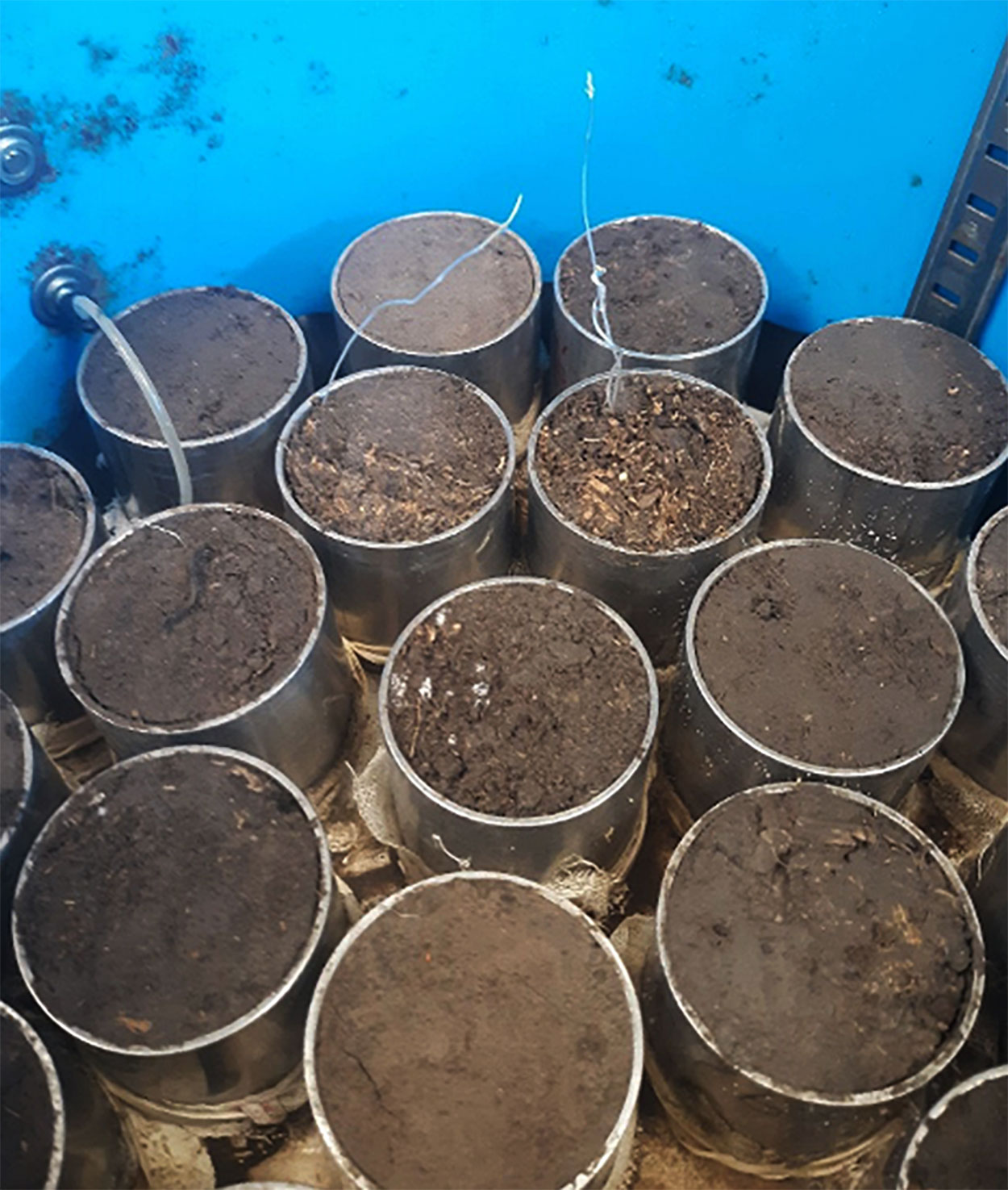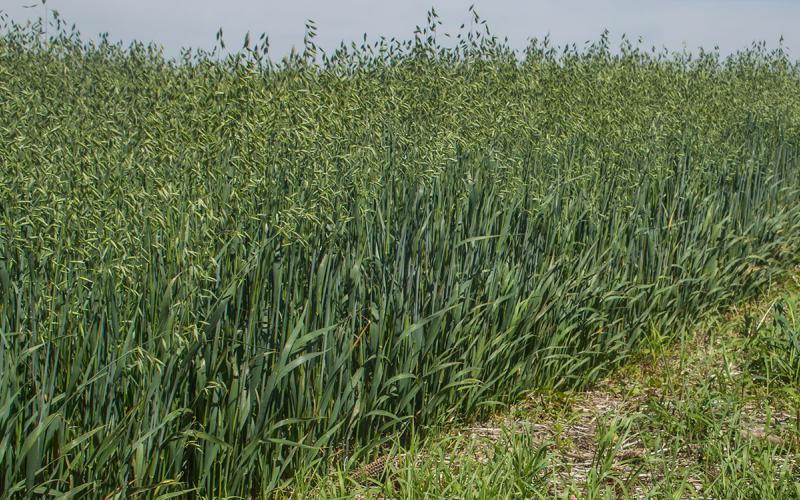Having adequate pore space in a soil is important for allowing air and water to move through the soil, and for plant roots to be able to penetrate through the soil. Bulk density is a commonly measured soil property that can indicate how compacted a soil is, and it can be used to calculate the percent pore space in the soil. Bulk density is the mass of soil solids + pores in a given volume of soil, and particle density is the mass of soil solids (sand, silt and clay particles and organic matter) in a certain volume of soil solids.
Determining Bulk Density
Trimmed Soil Cores
One method for determining bulk density is by pounding a ring into the soil of a known volume and then determining the mass of dry soil. A soil core sampler is frequently used to pound the ring into the soil. An example of a slide hammer device that is used to collect samples to measure soil bulk density can be seen in Figure 1. After cores are removed from the soil, the sample inside the ring is trimmed to be flush with the ends of the metal core. Soil is then removed, and soil mass (dried weight) inside the ring is determined. An example of trimmed soil cores is pictured in Figure 2.


Other methods for soil bulk density determination are with a soil probe (core) or the clod method.
Core Method
Core method bulk density is determined by inserting a metal probe into the soil of a known diameter and then cutting the soil to a measured length. The soil that was contained in the probe then can be dried to determine the oven dry mass of the sample that was taken with the probe. This can be measured on soil samples taken with push or hydraulic probes. The core method is generally not as accurate when compared with the clod or coring device methods.
Clod Method
When using the clod method, bulk density is determined by measuring the volume of a soil clod and then drying the clod to determine the mass of clod. This involves dipping the soil in paraffin wax, then determining its volume by displacement in water. For more information of techniques to measure soil bulk density, look at Blake & Hartge (1986), which is cited in the references.
In soils that have clays that shrink and swell, bulk density values may vary depending upon how wet or dry the sample was when it was collected.
Calculating Soil Properties
Sample Volume
The volume of the sample taken inside a metal ring or push probe can be calculated by Equation 1, where V is the volume of the sample, π is approximately 3.14, r is the radius of the sample (which is half the diameter of the sample), and l is the length of the soil sample.
- Equation 1: V = π × r2 × l
Once the sample is collected, it is then taken to the laboratory to be oven dried. Samples are frequently oven dried at 221 degrees Fahrenheit (105 degrees Celsius) for 24 hours then weighed to determine oven-dry soil mass.
Bulk Density
Equation 2 can be used to calculate bulk density. Where MDs is the mass of the oven-dry soil sample and Vs is the volume of the of the soil sample. Scientists usually report bulk density in the units of g cm-3, which can be converted to U.S. units from SI (metric) units, where 1 g cm-3 is equal to 62.3 lb. ft-3.
- Equation 2: Bulk Density = MDs ÷ Vs
Porosity
The bulk density of the soil can be used to calculate the percent pore space in the soil, which is referred to as porosity (p). Porosity can be calculated by Equation 3, where p is the porosity, Vv is volume void space and Vs is volume solids. The p in Equation 3 is in units of a fraction.
- Equation 3: P = Vv ÷ Vs
Another way that is frequently used to determine the porosity of the soil is the relationship between particle density and bulk density. P can be multiplied x 100 to get the percent pore space. The particle density of the soil is assumed to be about 165.1 lb ft-3 (2.65 g cm-3), which is about what the density of the primary minerals that make up soil solids are. Porosity can be calculated from bulk density by Equation 4.
- Equation 4: p = 1 - (bulk density ÷ particle density)
Ideal Soil Porosity
Ideal soil porosity is considered to be 50%, which corresponds to a bulk density of about 82.9 lb. ft-3 (1.33 g cm-3). Soil bulk density values can vary depending upon the depth below soil surface, sand, silt or clay content of the soil and the soil organic carbon content. Generally, sandy soils have a higher bulk density, and soils with higher clay and organic carbon content will have a lower bulk density. Bulk density is generally higher in the subsoil than in the topsoil. The Natural Resources Conservation Service shows the following bulk density values that are ideal for different soil textures and what bulk density values can restrict root growth in each soil texture (Table 1).
|
|
|
(lbs. ft-3) |
That Can Restrict Root Growth (g cm-3) |
That Can Restrict Root Growth (lbs. ft-3) |
|---|---|---|---|---|
| Sand, Loamy Sand |
|
|
|
|
| Sandy Loam, Loam |
|
|
|
|
| Sandy Clay Loam, Clay Loam |
|
|
|
|
| Silt, Silt Loam |
|
|
|
|
| Silty Clay Loam |
|
|
|
|
| Sandy Clay, Silty Clay |
|
|
|
|
| Clay |
|
|
|
|
Land Management Practices
Land management practices can affect soil bulk density. Driving agricultural equipment across the field can compact the soil, especially when fields are wet. Minimizing the amount of equipment driven throughout the field can reduce the risk of soil compaction in the field. Also, driving heavier equipment across field is more likely to increase soil bulk density. Much of the soil compaction occurs on the first pass, so following in the tire tracks of the first piece of equipment that crosses the field will minimize the percent of the field that has an increased bulk density. Having lower inflation pressure or weight of the implement spread out over a larger area, such as having more axles or wider tires, can reduce the increase in soil bulk density from agricultural equipment. More information on soil compaction in the Midwestern United States is available in the Upper Midwest Soil Compaction Guide (DeJong-Hughes & Daigh 2022).
To reduce soil bulk density, management practices can be done that increase soil organic carbon, protect the soil surface, reduce agricultural equipment trips across field and increase the number of roots in the soil that may create pores. Some management strategies that may do this are reduced or no tillage, retaining grain stover, and planting cover crops. However, recent review papers suggest planting cover crops reduced bulk density 31% of the time compared to no cover crops, retaining grain straw or stover reduced bulk density only 30% of the time compared to mechanical removal, and no tillage only reduced bulk density 19% of the time (Blanco-Canqui & Ruis 2020, Blanco-Canqui & Ruis 2018, Klopp & Blanco-Canqui 2022).
In Summary
Bulk density of the soil is an important indicator of soil physical health and is the mass of soil in a volume of soil. Having a desirable bulk density maintains soil pore space for air and water to move through the soil and for roots to be able to penetrate through the soil. Reducing weight and amount of traffic that travels through field can reduce the risk of bulk density increase from field operations.
References
- Blake, G.R. & Hartge, K.H. (1986). Bulk Density. In Methods of Soil Analysis, A. Klute (Ed.).
- Blanco‐Canqui, H., & Ruis, S. J. (2020). Cover crop impacts on soil physical properties: A review. Soil Science Society of America Journal, 84(5), 1527-1576.
- Blanco-Canqui, H., & Ruis, S. J. (2018). No-tillage and soil physical environment. Geoderma, 326, 164-200.
- DeJong-Hughes, J. & Daigh, A.L. M. (2022). Upper Midwest Soil Compaction Guide. University of Minnesota Extension Service.
- Klopp, H. W., & Blanco‐Canqui, H. (2022). Implications of crop residue removal on soil physical properties: A review. Soil Science Society of America Journal, 86(4), 979-1001.
- USDA NRCS. (2023, September 7). Soil Health Educators Guide.

